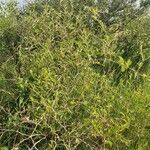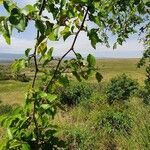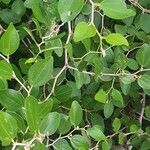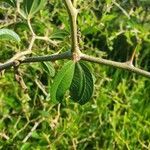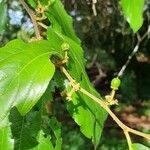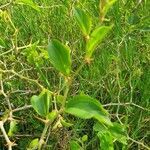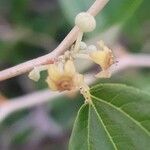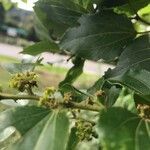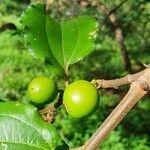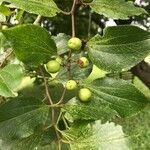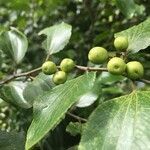A shrub or small tree. It grows up to 9 m tall. It has many sharp thorns. It has spreading and often drooping branches. The trunk is often crooked. The leaves are simple and alternate. They are shiny and have 3 veins from the base. The leaves are 2.5-8 cm long by 1.9-8 cm wide. Leaves and young plant parts can be hairy. There can be thorns at the nodes. The flowers are small and green. The flowers are in small clusters in the axils of leaves. The fruit are round. They are red and shiny. There is a sweet mealy pulp around a large seed.
Tree or shrub, 1-20 m high; sometimes decumbent or with rhizomes, often spinescent. Leaves alternate, petioled, entire or toothed, palmately veined. Flowers small, in short, axillary cymes. Calyx 5-fid; lobes keeled within. Petals 5(0), shorter than sepals, spathulate, usually clawed. Disc flat, adhering to calyx tube. Stamens 5, inserted outside disc, reflexed. Ovary superior, immersed in disc; styles 2-fid, stigmas papillose. Fruit a drupe, sometimes the size of a cherry. Seeds usually solitary, ± suborbicular, compressed.
Leaf-lamina ovate to broadly ovate, 4–7·7 × 2·8–4·7 cm., apex obtuse to acute or often mucronate, margin serrulate, base subcordate, markedly asymmetric, 3-nerved from the base, glabrous, glabrescent to tomentose; petiole up to 7 mm. long, glabrescent to tomentose; stipules usually spinescent, usually one hooked and one straight at each node.
Thorny shrub or small tree, 1-2(-20) m tall. Leaves drooping, ovate, 3-nerved from base, glossy, dentate, stipules paired, usually thorny, one straight and one hooked. Flowers in compact axillary cymes, green. Fruit a round drupe, with reddish brown to dark red leathery skin.
Often an individual will show a tendency not to produce spines, but usually a few branches on the tree can be found with spinescent stipules.
Cymes glabrescent to tomentose, sessile or shortly pedunculate; pedicels (1) 2 (-5) mm. long.
In seedlings the leaves are small and the spinescent stipules well-developed.
Petals cucullate with the limb ± 1 mm. in diam. and the claw 0·5 mm. long.
Shrub or tree to 12 m. in height; branchlets glabrous or pubescent.
Ovary immersed in the disk; style shortly 2-fid, up to 2 mm. long.
An erect or scandent shrub (or, in other parts of Africa, a tree)
Stamens with filaments up to 2 mm. long.
Fruits globose, c. 1·5 cm. in diam.
Sepals up to 2 mm. long, deltate.
Disk 2 mm. in diam., 10-lobed.
Dark reddish-brown branchlets
Flowers greenish-yellow.
Seeds compressed.
